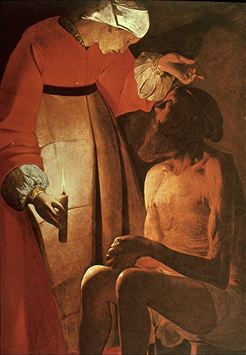145 x 97 cm.
Epinal, Musée départemental des Vosges.
This scene is a more sober one than those depicted in the preceding genre
paintings, yet its interpretation remains difficult.
Historians have catalogued it under the title "Visit to the Prisoner", a label that could serve as a convenient moral conclusion to the series of "cheating" scenes we just finished visiting. However, art specialists are now almost unanimous in identifying this light-and-shadow duo as Job being jeered by his wife.
As we explicitly mentioned above, when speaking of The Flea Catcher - and as you yourself
have no doubt noticed throughout your visit - light plays a major role in Georges de La
Tour's painting. Just as in Caravaggio's work, all is night and light, night and sun, night and flame.
Caravaggio, however, never shows the source of his light: it comes from outside,
from higher up; he portrays reality transcended. La Tour, on the other hand,
always depicts the source of light within his works. Light is designated in his paintings,
so that here the halo of light forming the center of the composition comes from the candle,
and everything turns around this center of gravity. An unending palaver proceeds from
one face to another, from the faces to the candle, from the hands
to the faces, from misery to comfort, from well-being to decline, as if in an eternal cycle of
questioning. The shadow-and-light dualism is a historian's concept, whereas the other philosophic
and metaphysical duality brought to light here by the artist is defined by the composition, by the
staging in space of the subject figures. Hence here, the wife - enormously big and tall, wearing
her belt very high and featuring a small head, as if deformed by anamorphosis - asserts herself
through an extremely solid and stable position, almost threatening, above the precarious, fragile and
derisory situation in which Job is portrayed. The artist's statement is thus simplified, purified:
only two figures, staged in the light of a single flame. By reverse effect, this simplification
renders his statement all the stronger and more expressive.
This intensity will reappear in the second part of our visit:
the religious paintings

Before going on to the second part,
you are welcome to make a quick return visit to any
of the
chapters
on secular works.

You can also return to the beginning of the program
.

